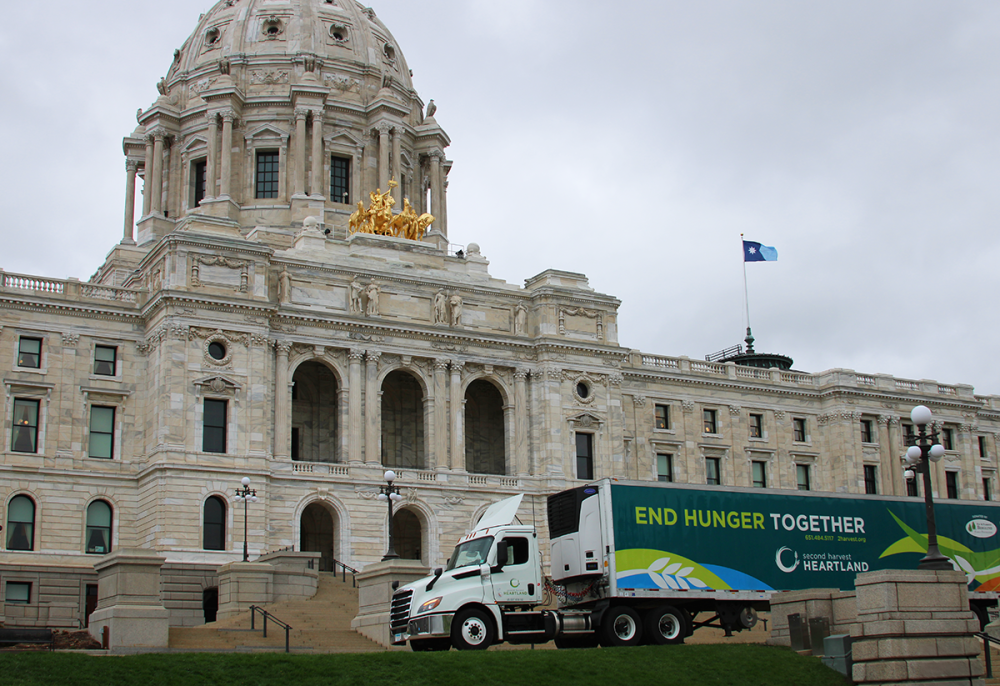
Advocacy in Action: Results from the 2025 Minnesota Legislative Session
Note: Less than a week after the legislature adjourned, House Speaker Emerita Melissa Hortman and her husband, Mark, were killed in a politically motivated shooting that also targeted State Senator John Hoffman and his wife Yvette, both of whom are expected to recover. Read more about this enormous loss for the state of Minnesota from our Public Affairs team here.
The Minnesota State Legislature finished their regular business on Monday, June 9, after a dynamic and chaotic legislative session. Legislators were tasked with making tough decisions on the state budget and needed to find bipartisan compromise given a narrow 34-33 split in the State Senate and a 67-67 tie in the House of Representatives. At Second Harvest Heartland, we are celebrating some bipartisan legislative funding wins while also acknowledging that both state and federal funding cuts will pose significant challenges for the hunger-relief network.
We want to thank everyone who advocated for hunger-relief funding during this legislative session. Whether you were one of the 200+ Hunger Day on the Hill attendees, helped us pack food boxes on the capitol lawn during Pack the Capitol, testified on a bill, or sent messages to your legislators, it all made a difference. All told, anti-hunger advocates like you sent more than 12,000 messages to state policymakers this year—and they listened!
Neighbor Services Outreach Manager Mesa Siebert testifying in front of the Senate Health and Human Services committee on behalf of hunger-relief policies.
As a result of our collective advocacy, the state Health and Human Services budget included this one-time funding for hunger relief:
- $5 million distributed between all Minnesota food banks and participating Tribal Nations
- $5 million additional funding for Minnesota food shelves, which will nearly double the funding available for the Minnesota Food Shelf Program grants this fall
- $1 million for the prepared meals competitive grant program
- $1 million for Tribal food security through the American Indian Food Sovereignty program
Unfortunately, Farm to Food Shelf, a program that helped us source abundant, fresh produce directly from local farmers for the last ten years, was cut from the state budget, which will lead to a loss of roughly 4 million pounds of fresh produce per year going forward, even while the funding allocated to food banks to purchase milk was extended and increased slightly.
Finally, a new state-level Local Food Purchasing Assistance (LFPA) program was created this year, providing opportunities for hunger-relief organizations and many others to work with local farmers to purchase food at market rates. $700,000 in funding will be available annually through a competitive grant, which will likely be available starting in late 2025 or early 2026.
Proposals supported by Second Harvest Heartland and our hunger-relief allies that did not move forward in 2025 include:
- A “Fresh Bucks” pilot to provide matching funds for SNAP recipients to purchase fresh produce from select grocery stores, modeled after the existing Market Bucks program.
- A proposal to increase the minimum SNAP benefit for seniors from $23 to $50 a month.
- A proposal to maintain funding for the state-level SNAP Outreach Program. (This funding will be reduced from $1 million a year to $500,000 a year starting July 1.)
- A grant program to provide additional funding to food shelves for infrastructure and capital improvements.
All told, the effect of these developments is that there will be less funding available for food sourcing than last year. The one-time funding food banks and food shelves will receive is both critical and worth celebrating, yet it is far from what the hunger relief network requires to keep up with community need, especially in the wake of cuts to TEFAP CCC funding earlier this year, the elimination of the Farm to Food Shelf program, and the looming threat of cuts to SNAP.
Become an Advocate
Want to help? Join our list of hunger-relief advocates to stay updated on our current priorities and learn more about upcoming events, educational opportunities, grassroots activities and other ways that you can support our work to end hunger together. Sign up here.
